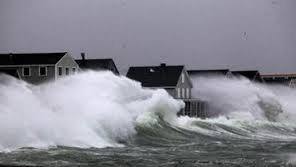By Doug Struck
Globe Correspondent
This is a time when journalists traditionally look back over the previous year. Let’s take a wider retrospective, say, 4,300 years.
The rise in sea level during the last century along the mid-Atlantic coast is faster than the seas have risen in the last 4.3 millennia, according to a geologic study published this month by five researchers from Rutgers University and Tufts University.
The research adds to the alarm that should have us looking for higher ground as climate change propels us toward a new and not-so-improved planet.
We have known the seas are rising, swollen like a warming balloon and fed by melting glaciers. And we have known that the waters of the east coast are rising faster than the global average, an anomaly of wind, currents and sinking land.
But the latest study, published inEarth’s Future, an open-source, online journal published by the American Geophysical Union, gives some perspective about how we should place the significance of these changes. Probably about 10 on a scale of 10.
“We are only beginning to glimpse the sea level change in comparison with what we know about temperature,” said Andrew C. Kemp, an assistant professor at Tufts’ Department of Earth and Ocean Sciences, one of the authors of the study. “What we are starting to see is this rate of rise [of the last 130 years] is really unusual.”
The other authors were Kenneth G. Miller, Robert E. Kopp, Benjamin P. Horton and James V. Browning of Rutgers University.
Their study looked at modern tide gauges and soil sediment samples from old and ancient salt marshes, and factored in soil subsidence to document historic sea rise. Melting glaciers more than 6000 years ago prompted rapid sea level rise– as much as 16 inches a year. But in man’s modern history, the seas grew at a modest two-tenths inch per year, until the industrial age began spewing carbon dioxide into the atmosphere about 1880. Since then, the rate has increased sharply, and the acceleration is “poorly constrained,” the report says. In layman’s terms, that means a runaway train going downhill with no brakes.
The study predicts a sea-level rise in mid-Atlantic locations by 2050 ranging from 11 inches to 26 inches, accelerating by 2100 to a range of 26 inches to 66 inches. This is significantly higher than predictions of the Intergovernmental Panel on Climate Change, which have been criticized as too conservative and did not, according to the authors of the study, contemplate accelerating melting in Greenland and the Antarctic.
The implications of this are sobering for Boston, which lives cheek-by-jowl with the sea. Although the study was based on geologic evidence in the mid-Atlantic states from New York to Virginia, the authors noted it carries warnings for other regions.
Flooding from a storm is dependent not only on the ferocity of the storm and the tides, but the level of the seas from which the storm waves rise. So higher sea levels mean widespread flooding will result from even moderate storms. The authors note that by 2100, a routine “ten year storm”—a storm that has a 10 percent chance of occurring in any year– will produce as much flooding as today’s so-called “100-storm,” a muscular storm of a strength currently given a 1 percent chance of occurring in any year.
Sea level rise means that by 2100, “even a modest nor’easter… will exceed the current 100 year storm, and it would also exceed all historic storms at Atlantic City,” the authors warn.
In fact, the new flood-zone maps by the Federal Emergency Management Agency that are causing such consternation already are inadequate for future long-term planning, the authors contend. The study contends the storms rolling off higher seas will be crucial for property owners sooner rather than later.
“We are very guilty of an obsession with the year 2100,” said Kemp. “If you are renovating a house, that’s a long way away.” But a possible sea rise of up to two feet in the next 35 years might cause one to reconsider the investment.
“Planners should account for rising sea levels,” the authors note. And the more catastrophic the vulnerable area, the more imperative for those authorities to plan for the highest predicted sea levels.
(Photo credit: Boston.com)